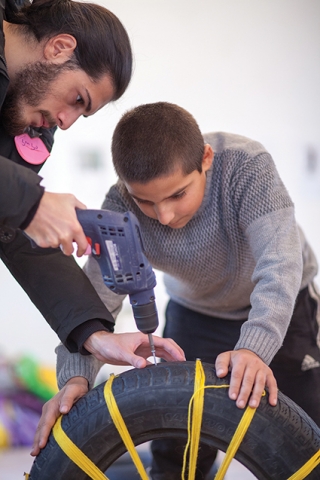Culture - A Common Language with Street Children
Fund AhuAhu for culture development was founded in 2010. The main objectives include the development of contemporary art, and the resolving of social problems with the involvement of citizen engagement and a culture component. The fund has been carrying out the project “Culture - as the common language of communication with difficult groups” with the help of volunteers and in cooperation with the centers of the Caritas, Child and Environment, and SOS Children. Georgia Today met up with Anuka Lomidze, the founder of the fund of AhuAhu to find out more.
Ana, can you introduce the principles of ‘Culture – as a language of communication’ to us?
All members of our project, including the coordinator and the head, are volunteers. The project is held without any financial support, depending on volunteers, friends and relatives. We do our job with joint effort that needs children and adults to communicate and integrate with each other. The principle is simple: You are a creative person (artist, musician, director, actor, singer, and dancer) and are able to give a one or three day workshop with children and adults, depending on your job. During the workshop, they will learn to how to paint, dance, sing etc. You take five interesting friends along with you who can help during the workshop and make friends with those kids and adults, together with you. You all bake delicious food at home and after the workshop or during a break welcome them to the table. All of us, including the children, make new friends and spend our time positively, give and take back creative energy and make happy those who need it most.
Who are the children living and working on streets?
The terms ‘street children’ or ‘ownerless children’ [a Georgian term] are not correct. In fact these are children living and working on the streets. There are no ownerless children at all. Actually, every single one has a parent, a guardian in the form of the state. Some of them do not have a name, house, parents; are half-orphan or from very poor families so that the streets have become a single food source for them. Sometimes willingly or forcibly they work, beg and get into prostitution or other illegal jobs on the streets. Six years ago we happened to have an accident when a 14 year old boy was shot in the leg. Because he had no identification card was refused medical care, he got blood poisoning and lost his leg. They are deprived of education because they have no identity card. They have no toys, personal items or rooms, beds or safe places.
As we know, two years ago, the fund Metro Freedom Square foyer displayed social posters depicting children problems that are still there.
Yes. The series was filmed according to the ‘Culture-as the common language’ principle and with their direct involvement and friendship.
The author of the photos, Coca Vashakidze, spent several days with the children in a day care center, where they came into contact with each other, became friends, and together came up with the content and worked together during the making of it, selecting photos that were put on the walls of their building. The exhibition was organized in the framework of the “I’m a citizen, too” project with the collaboration of AhuAhu – Fund for Culture Development, Civil Society Development Center and Helping Hand.
What can ordinary people do for these children?
Anyone can make friends with the children. Talk with them about literature, art, music, theater, and cinema. Also, organize creative workshops and excursions and pay a visit to cultural and educational places or take them to the theater, gallery, and thematic exhibitions. Teach them a foreign language, geography, history, mathematics and other subjects. Read books, show films, prepare food, and they will learn to pass it on.
What is the current program of ‘Culture as a Communication language”?
We plan art-therapy sessions, free screenings, reading hours, creative courses of English language workshops, visits to playwrights, artists and photographers, educational and fun courses in history and geography, music courses, excursions to exhibition halls and museums. At this moment, art therapy sessions, free screenings and meetings with dramatists are conducted for the Caritas and Child and Environment children.
What do you need for the development of the project?
Any material which will be useful for creative activities. Even food to eat between activities (for example, at screenplays and discussions we have to stop twice with small food break) of volunteers willing to take a new, exciting knowledge, abilities, attitudes and creative spirit of friendship.
Our fund has no a working space, the most important thing for us is to find a neutral place where we can be in a more stable relationship with the child and grow with them and become more diverse.
We would be happy if others shared their advice, wishes or project development opportunities on our Facebook page. We are always open to cooperation and new members and really need to unite with people of innovative vision to arrive at a solution to such problems.
https://www.facebook.com/Culturelanguageforcommunication/info/?tab=page_info
Meri Taliashvili












